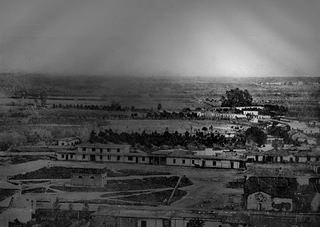El Aliso del Viento, the historical landmark of the Tongva people
El Aliso del Viento sprang from the ground near the western bank of the Los Angeles River in the late fifteenth century — in an ominous coincidence, about the same time Columbus arrived in the Americas. Growing about one mile from Azusa Street on the other side of the L.A. River, the tree cut an imposing figure. It measured 60 feet tall and 22 feet around the trunk. Its canopy spread nearly 200 feet from tip to tip. Each year, the tree repeated its cycles—casting off leaves, resprouting them, dropping seeds, and stretching out ever so slightly—even as the surrounding landscape morphed from fertile flood plain into gritty city center. As it matured, the sycamore — located at the juncture of the Los Angeles coastal plain and the San Fernando and San Gabriel valleys — became a gathering place for Los Angeles’ indigenous Tongva people. Local leaders traveled from their villages across Southern California to confer under the shade of the tree’s canopy.
The sprawling sycamore gained almost totemic significance. In a landscape virtually free of permanent structures, the towering tree would have been visible for a great distance, and in the summer heat it would have provided welcome relief from the sun. The Tongva reportedly reckoned distances in relation to the tree, and traders from as far away as present-day Yuma knew the tree as a landmark. By the mid-eighteenth century, the mighty sycamore stood at the center of one of the largest Tongva villages, Yaanga.
The tree continued to grow in height and breadth as Spain colonized the region and radically transformed life in the village under the sycamore’s boughs. Impervious to the political and cultural whirlwind surrounding it, the tree acquired a new, Castilian name: El Aliso. (“Aliso” typically refers to an alder tree, but in Alta California it was often mistakenly applied to sycamores, as well.) In 1781, Spain founded a new agricultural settlement within a stone’s throw of El Aliso: El Pueblo de la Reina de Los Angeles.
Early Angelenos depended on the inhabitants of Yaanga for manual labor and for hand-made goods. But Spanish colonization soon devastated the Tongva village. Many residents were drawn to the nearby Mission San Gabriel Arcangel, where missionaries imposed Spanish culture upon those who converted. Those who remained in Yaanga lived under the increasingly dominant sway of the pueblo, which slowly encroached on the village. By the 1830s, El Aliso had ceased to function as the symbolic center of daily Tongva life as Yaanga changed locations twice before dissolving into historical oblivion.


